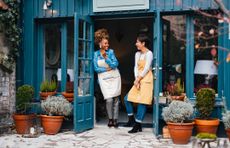Best Investing Moves for Retirees
This what you've planned for. Now, to keep the income flowing.


You can finally head off into the sunset, enjoying your hard-earned financial security without a care in the world. Alas, not quite. Now you shift your focus from helping your money grow to making it last.
Best Investing Moves at Every Age
- Best Investing Moves When You're Starting Out
- Best Investing Moves for Young Families
- Best Investing Moves for Empty Nesters
- Best Investing Moves for Pre-Retirees
Create investment buckets
At this stage, you must walk a fine line in building your portfolio. “Retirees who are heavy on stocks must be comfortable with the market risk,” meaning the risk of stock prices falling, says Maria Bruno, senior investment strategist with Vanguard’s Investment Strategy Group. “The flip side is that if they have too little in stocks, their portfolios may not keep up with inflation.”
Using a bucket system is one way to balance both risks. Here’s how it works: Hold one year’s worth of expenses in cash. That’s your first bucket. Hold enough money in your second bucket to cover your expenses for the next nine years, and invest this in high-quality bonds or a fixed annuity (our model portfolio assumes you are withdrawing 4% per year, meaning this bucket accounts for 36% of your portfolio). Your third bucket may be invested in stocks and other aggressive options. If a bear market roars, you can sleep easy knowing that you don’t need to touch your stock holdings for a decade (for more strategies to make your money last, see 12 Strategies to Generate Income in Retirement.).

Sign up for Kiplinger’s Free E-Newsletters
Profit and prosper with the best of expert advice on investing, taxes, retirement, personal finance and more - straight to your e-mail.
Profit and prosper with the best of expert advice - straight to your e-mail.
Invest for income and growth
In a perfect world, you could hold a conservative portfolio of bonds and live comfortably off coupon payments. In the real world, you need to get a bit more creative. “In a higher-interest-rate environment, spending only income could be feasible, but today it’s not,” says Bruno. Avoid the temptation to load up on junk bonds and stocks with superhigh yields to boost your portfolio’s payout to 4%. Instead, you need a mix of investment types to provide both income and capital appreciation. The second bucket in our model portfolio holds two conservative bond funds instead of higher-yielding options because that’s the money that lets you sleep at night. Consider replacing some of your taxable bond funds with tax-free municipal bond funds if you have a lot of money in taxable accounts and are in a high tax bracket. Riskier income investments, including small allocations to REITs, junk bonds and emerging-markets debt, are sequestered in the third bucket. The third bucket also houses a 30% allocation to broad stock index funds, so you’ll always capture the market’s growth.
Refill your buckets as needed
Replenish your buckets periodically by trimming top performers in your third bucket and by selling bond-fund shares as necessary to refill the cash bucket. If the market tanks, hold off on touching your stock funds until they recover, even if doing so means you draw down your second bucket for a few years to pay for living expenses.
Portfolio
Bucket 1
4% Cash
Bucket 2
20% Metropolitan West Total Return Bond M (MWTRX)
16% Vanguard Short-Term
Investment-Grade (VFSTX)
Bucket 3
25% Schwab Total Stock Market Index (SWTSX) or ETF alternative: Vanguard Total Stock Market (VTI)
10% T. Rowe Price Dividend Growth (PRDGX)
10% Fidelity Real Estate Index (FRXIX) or ETF alternative: Schwab U.S. REIT (SCHH)
5% Vanguard Total Intl Stock Index (VGTSX) or ETF alternative: Vanguard Total International Stock (VXUS)
5% Vanguard High-Yield Corporate (VWEHX)
5% Fidelity New Markets Income (FNMIX)
Get Kiplinger Today newsletter — free
Profit and prosper with the best of Kiplinger's advice on investing, taxes, retirement, personal finance and much more. Delivered daily. Enter your email in the box and click Sign Me Up.

-
 Stock Market Today: Stocks Dragged Down by Strong Data
Stock Market Today: Stocks Dragged Down by Strong DataInvestors weigh the prospect of no more rate cuts in the current cycle.
By David Dittman Published
-
 The Verizon Administrative Settlement Payment is a Reminder Class-Action Lawsuits Won't Make You Rich
The Verizon Administrative Settlement Payment is a Reminder Class-Action Lawsuits Won't Make You RichPeople are receiving payouts from the Verizon administrative settlement and are surprised at how small they are. This provides a helpful financial lesson reminder.
By Alexandra Svokos Published
-
 457 Plan Contribution Limits for 2025
457 Plan Contribution Limits for 2025Retirement plans There are higher 457 plan contribution limits for state and local government workers in 2025 than in 2024.
By Kathryn Pomroy Last updated
-
 What Does Medicare Not Cover? Seven Things You Should Know
What Does Medicare Not Cover? Seven Things You Should KnowHealthy Living on a Budget Medicare Part A and Part B leave gaps in your healthcare coverage. But Medicare Advantage has problems, too.
By Donna LeValley Last updated
-
 13 Smart Estate Planning Moves
13 Smart Estate Planning Movesretirement Follow this estate planning checklist for you (and your heirs) to hold on to more of your hard-earned money.
By Janet Kidd Stewart Last updated
-
 Medicare Basics: 11 Things You Need to Know
Medicare Basics: 11 Things You Need to KnowMedicare There's Medicare Part A, Part B, Part D, Medigap plans, Medicare Advantage plans and so on. We sort out the confusion about signing up for Medicare — and much more.
By Catherine Siskos Last updated
-
 The Seven Worst Assets to Leave Your Kids or Grandkids
The Seven Worst Assets to Leave Your Kids or Grandkidsinheritance Leaving these assets to your loved ones may be more trouble than it’s worth. Here's how to avoid adding to their grief after you're gone.
By David Rodeck Last updated
-
 SEP IRA Contribution Limits for 2024 and 2025
SEP IRA Contribution Limits for 2024 and 2025SEP IRA A good option for small business owners, SEP IRAs allow individual annual contributions of as much as $69,000 in 2024 and $70,000 in 2025..
By Jackie Stewart Last updated
-
 Roth IRA Contribution Limits for 2024 and 2025
Roth IRA Contribution Limits for 2024 and 2025Roth IRAs Roth IRA contribution limits have gone up. Here's what you need to know.
By Jackie Stewart Last updated
-
 SIMPLE IRA Contribution Limits for 2024 and 2025
SIMPLE IRA Contribution Limits for 2024 and 2025simple IRA The SIMPLE IRA contribution limit increased by $500 for 2025. Workers at small businesses can contribute up to $16,500 or $20,000 if 50 or over and $21,750 if 60-63.
By Jackie Stewart Last updated